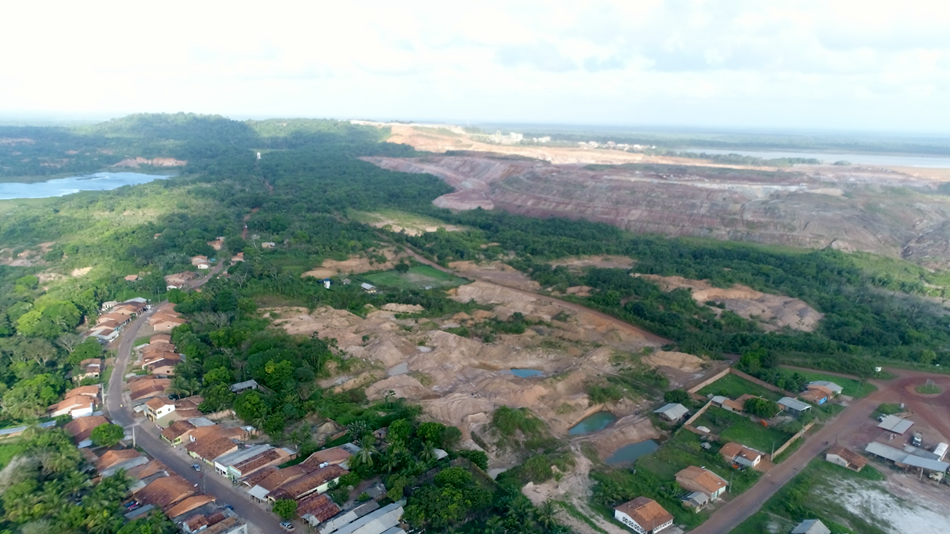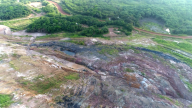By Tádzio Coelho, professor in the Social Science department at Viçosa Federal University, Brazil, This article was originally published on Brasil de Fato.
On March 25th, news and a video on social networks reported flooding of roads and a lake in the community of Aurizona, located in the municipality of Godofredo Viana in Maranhão State. It seems the flood was caused by Mineração Aurizona S.A. (MASA), a subsidiary of Canadian mining company Equinox Gold. The videos caused consternation mainly because of the presence of a mining tailings dam, owned by MASA, with a volume of around 10 million m3, comparable to the volume from the Vale dam burst in Brumadinho.
I have followed the Equinox Gold mining project for two years. Today, it is one of the five largest gold mining projects in Brazil. This article seeks to highlight the lack of social control, public participation, inspection, and monitoring at the Equinox Gold project in Godofredo Viana, which in a broader interpretation could be defined as “the Brazilian minng model”.
As mentioned, Aurizona, a community of about 4,000 people, and other communities live next to the Equinox mine site. It is not the first time that the mining company has damaged the environment and affected the local population. In addition to the dam, there are piles of waste rock, which reach 30 metres in height. These are located very close to where the communities live. On November 4th, 2018, a waste rock landslide blocked road access to the community and affected mangroves and natural water streams. As seen in the photo below, the material swept the road away affecting a mangrove habitat and devastating the landscape. An area of approximately 100 m2 of mangroves was affected.
According to the company’s official press release, “what happened will be investigated so the causes can be fully known.” The causes of the landslide remain unclear. Also, according to local councillors and fishermen, leaking material from the mine site reached local streams in 2014, causing the death of the fish. It is not known from what infrastructure the material came from and further demonstrates the company’s lack of social control and monitoring.
While conducting this research, we have identified serious problems with the monitoring and licensing of the dam. According to the Vené Dam Emergency Action Plan (Geohydrotech, 2015), “There are no residents in the area downstream of the dam” and “in case of rupture, the waste will be directed to the mine pit.” However, we found numerous residences around the dam. The Emergency Action Plan also recommends external and internal simulation of disruption to be carried out. In terms of the external simulation, this has never been carried out according to residents.
In addition, I found that it was not possible to access some documents. Through an official request to the Environment Secretariat (SEMA), we obtained the Emergency Action Plan, but it was incomplete. The document mentions flood maps of a hypothetical dam rupture that were not made available to us. This is concerning. There are two reasons that may explain this: the first is that SEMA has deliberately chosen not to provide the flood maps; the second reason, which is even more troubling, is that there are no such maps in the dam's documentation.
Regarding this year’s flood, I prefer not to speculate on events that could have caused it, but from the March 25th video, we can see that the Juiz de Fora lake was hit by the flood, which is quite concerning because it is the water source for the Aurizona population’s household consumption. Therefore, it is essential to know from which of the company’s structures this water came from and where that water passed through, considering the presence of waste material between the reservoirs/dam and the Juiz de Fora lake. The fact is that the population is isolated and without access to drinking water amidst a peak of contamination and deaths by COVID-19. We hope that at least this time the company will be held accountable and provide all the necessary explanations and repairs all the damages caused to the population and the environment.
In my research, I conclude that the Aurizona project is being developed with a decision-making process that prioritizes the company’s interests and ignores municipal authorities and the local population and communities. This project is characterized by a lack of transparency and public participation in the deliberative processes, specialization in large-scale extraction mining to the detriment of other economic activities, and lack of official inspection and monitoring of mining and processing infrastructures, which seems to be an exclusive responsibility of the company – features that also describe the Brazilian mining model.

